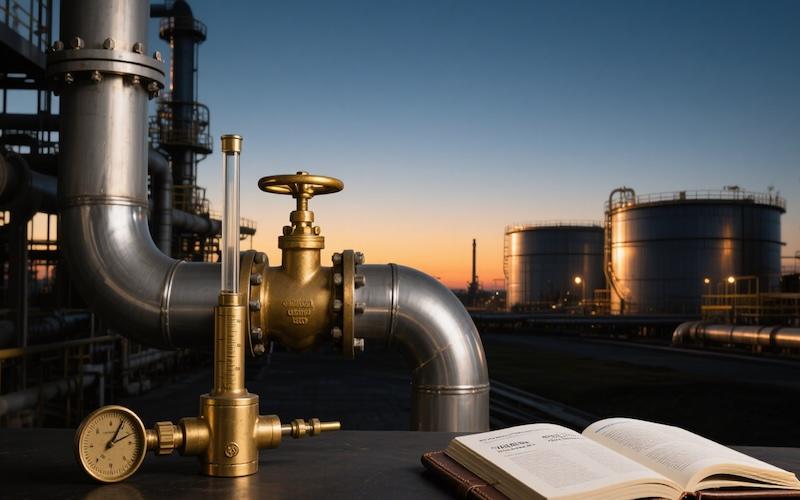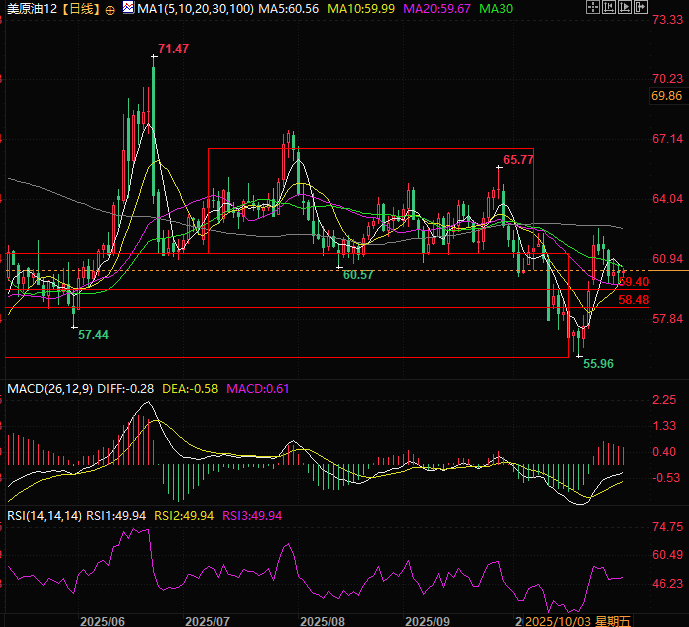Crude oil demand is alarming, yet global giants are ramping up production! The high-stakes gamble behind it is coming to light.
2025-10-31 20:35:49
As long as concerns about oversupply continue to fester, market sentiment is expected to remain predominantly bearish in the coming trading days. However, it is worth noting that oil prices have been adjusting for four consecutive days recently, but have firmly held above the 10-day and 20-day moving averages.

This weekend, OPEC+, comprised of the world's major oil-producing nations, will hold a meeting. Just days before this meeting, the United States imposed restrictions on two major Russian oil companies, which are core allies of OPEC+.
These restrictions initially fueled short-term expectations of a “supply contraction,” driving a significant rebound in U.S. crude oil prices in recent weeks.
However, as the meeting approaches, the market anticipates that OPEC+ will take into account the disruption to Russian oil production, which may lead the organization to announce a larger-than-expected increase in production in its upcoming announcement.
However, a strange phenomenon is that oil prices have not fallen significantly in the face of OPEC's potential production increase plan, while major oil-producing companies have followed suit by expanding production.
Throughout 2025, OPEC+ will maintain its strategy of gradually increasing production.
To date, the organization has cumulatively increased production by 2.7 million barrels per day, partially reversing the voluntary production cuts implemented in previous years and steadily releasing more supply into the market. The market expects at least a production increase of 137,000 barrels per day for this weekend's decision; however, if OPEC+ decides to offset the supply gap from Russia caused by US sanctions, the final increase could be even greater.
This article briefly lists the trends and possible reasons why oil giants continue to increase production despite the oversupply problem.
Despite supply and demand pressures and price pressures, international oil giants continue to expand production.
Despite weaker crude oil prices this year and global supply growth consistently outpacing demand growth, setting the stage for a supply glut in the coming months, leading international oil companies are still expanding production. European oil giants have restarted exploration and development plans for new oil and gas fields. In previous years, they had attempted to generate profits and reasonable returns from low-carbon energy projects such as renewable electricity, green hydrogen, and biofuels; however, most of these attempts ended in failure.
International oil giants set new production records and are shifting their strategic focus back to oil and gas.
U.S. oil giants ExxonMobil and Chevron achieved record crude oil production in the Permian Basin, one of the world's top shale producing regions, while also betting on expansion of international projects in Guyana, Kazakhstan, and other countries.
Following ExxonMobil's acquisition of Pioneer Natural Resources and Chevron's acquisition of Hess, both U.S. giants reported record-high production figures in the Permian Basin and globally during the second quarter of this year. TotalEnergies predicts that despite a $10 per barrel drop in oil prices this year compared to last year, increased oil and gas production will still drive profit growth in the third quarter.
Other European oil giants, Shell and BP, are also seeing increased production.
These European giants have refocused on their core oil and gas business, a strategic shift that began after the energy crisis—which made energy security and affordability more important than sustainability. At the same time, high interest rates and supply chain problems further squeezed the already meager returns of clean energy projects, causing many new energy projects to lose competitiveness.
International oil giants are betting on long-term demand resilience, focusing on long-term profits while ignoring market fluctuations.
Despite the combined efforts of international oil giants and the national oil companies of OPEC+ countries (which have continued to lift production cuts this year) to increase the current market oversupply pressure, they remain confident in their ability to withstand the current low oil prices and market glut.
International oil giants have decided to increase investment in the oil and gas sector to meet robust demand until at least the mid-2030s, and are therefore no longer overly concerned about short-term fundamentals and noise about oversupply.
Earlier this year, the International Energy Agency (IEA) reiterated its forecast that oil demand would peak at the end of this decade, but international oil giants generally do not agree that demand will peak before 2030.
BP suggested last year that global oil demand could peak as early as this year, but in its latest annual Energy Outlook released last month, the company abandoned that prediction.
The report points out that due to slower-than-expected improvements in energy efficiency, oil demand is projected to continue growing until 2030.
Most oil giants believe that oil demand will peak sometime in the 2030s, but no one expects demand to decline rapidly after the peak. All the giants also say that oil and gas will remain an indispensable energy source for global economic growth and development until 2050.
In its 2025 Global Outlook, ExxonMobil stated, "Oil and gas are of paramount importance, and there is currently no other viable path to meet global energy demand."
The U.S. oil giant stated, "Our Global Outlook predicts that by 2050, oil and gas will account for more than half of the global energy supply."
We expect oil demand to stabilize after 2030, but will remain above 100 million barrels per day until 2050. "All major credible scenarios indicate that oil and natural gas will remain the dominant energy sources until 2050."
The 2025 Energy Security Scenario Report validated the economic outlook.
Shell analyzed three scenarios in its "Energy Security Scenario 2025," and all three showed that "approximately $600 billion will need to be invested annually in the upstream sector over the next few decades—as oil and gas fields are declining at a rate two to three times faster than the annual decline in future demand."
ExxonMobil and today's European oil giants are all looking to the long term – increasing investment in new oil and gas supplies at the expense of reducing investment in renewable energy, and offsetting the impact of accelerated natural decline in existing oil and gas fields through increased production.
Even the International Energy Agency acknowledged last month that, due to the accelerated decline in production from existing oil fields, the world still needs to develop new oil and gas resources to maintain stable output. This represents a significant shift from the agency's statement in 2021, when it stated that, under a scenario of achieving net-zero emissions by 2050, "no new oil and gas investment will be required."
Exploration has once again become a core issue for international oil giants, who have clear confidence in the stability of demand for their product (oil) over the next few decades. The large-scale supply glut expected later this year and early next year has not deterred these giants from expanding production.
These companies are cutting costs by laying off thousands of employees to ensure they can still pay dividends to shareholders at oil prices of $60 a barrel. Several companies have pledged billions of dollars to optimize costs and streamline their corporate structures. This move aims to eliminate operational inefficiencies and excess costs while maintaining shareholder returns despite oil prices being far below their 2022 highs.
This year, increased oil and gas production has, to some extent, offset the negative impact of weaker oil prices. Analysts say the increased production has also allowed these leading global oil companies to position themselves for profit growth in the next year or two once the supply glut eases.
Barclays analyst Betty Jiang said this week, "The new supply currently flooding the market is narrowing OPEC's spare capacity space, so the market is seeing a glimmer of hope."
"Whether it's the second half of 2026 or 2027, the market supply and demand balance will eventually tighten; it's only a matter of time."
Technical Analysis:
After a rapid rebound driven by events, the December futures contract for US crude oil firmly held above the 10-day and 20-day moving averages, and did not touch the key price levels of 59.40 and 58.48, demonstrating the resilience of oil prices.
If crude oil can maintain its current price level, the 5-day and 30-day moving averages will move down and become support levels. Oil prices are expected to break through 61.30, return to the upper trading range, and trade within that range.

(Daily chart of US crude oil December futures contract, source: FX678)
At 20:27 Beijing time, the December futures contract for US crude oil was trading at $60.44 per barrel.
- Risk Warning and Disclaimer
- The market involves risk, and trading may not be suitable for all investors. This article is for reference only and does not constitute personal investment advice, nor does it take into account certain users’ specific investment objectives, financial situation, or other needs. Any investment decisions made based on this information are at your own risk.





















